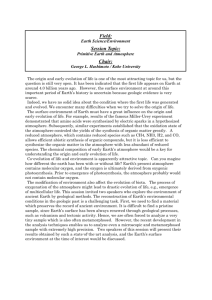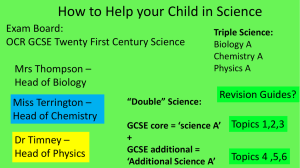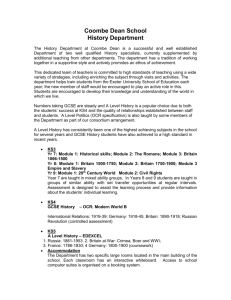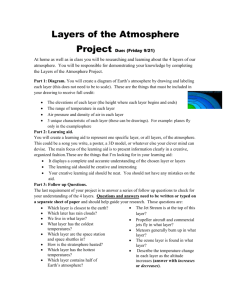Module C5 - Chemicals of the natural environment - Scheme
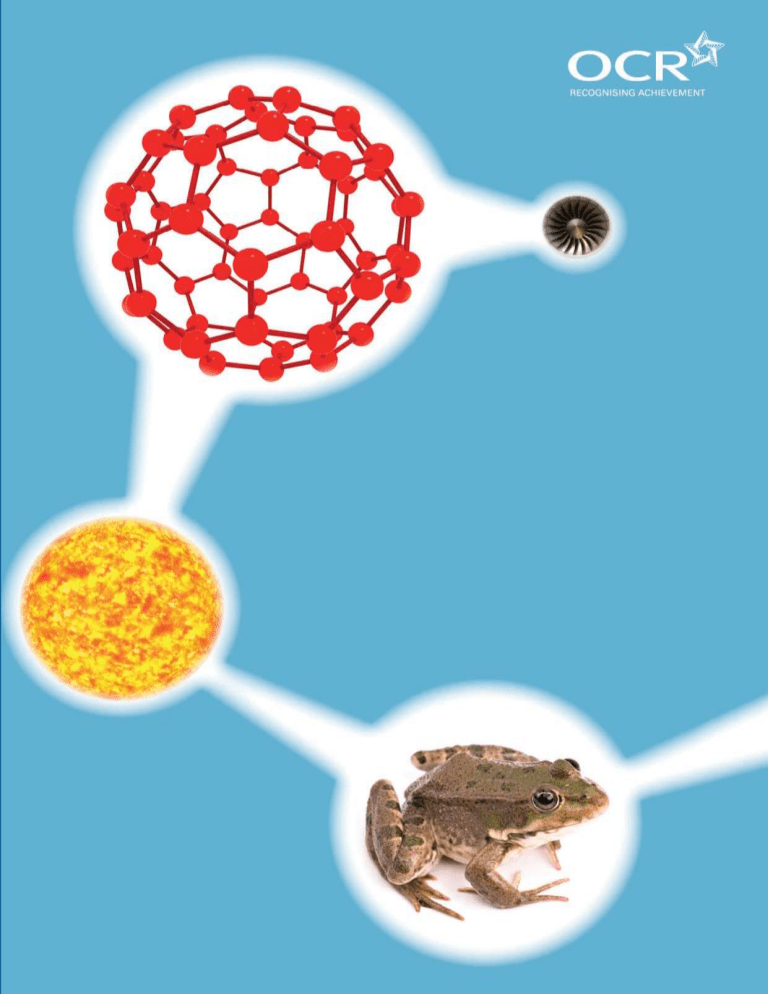
TWENTY FIRST CENTURY
SCIENCE SUITE
SCHEMES OF WORK
AND LESSON PLANS
C5: Chemicals of the natural environment
VERSION 1 JULY 2011
Introduction
OCR involves teachers in the development of new support materials to capture current teaching practices tailored to our new specifications. These support materials are designed to inspire teachers and facilitate different ideas and teaching practices. Each Scheme of Work and set of sample Lesson Plans is provided in Word format – so that you can use it as a foundation to build upon and amend the content to suit your teaching style and students’ needs.
The Scheme of Work and sample Lesson plans provide examples of how to teach this unit and the teaching hours are suggestions only. Some or all of it may be applicable to your teaching.
The Specification is the document on which assessment is based and specifies what content and skills need to be covered in delivering the course. At all times, therefore, this Support Material booklet should be read in conjunction with the Specification. If clarification on a particular point is sought then that clarification should be found in the Specification itself. References to the content statements for each lesson are given in the ‘Points to note’ column.
© OCR
Page 2 of 9 GCSE 21 st Century Science Chemistry A J244
V1.0
Module C5: Chemicals of the natural environment
Sample Scheme of Work
GCSE 21
st
Century Science Chemistry A J244
Module C5: Chemicals of the natural environment
Suggested Teaching Time: 13 Hours
Topic outline
Suggested teaching and homework activities
Composition of the Earth’s atmosphere
(1 hour)
Students can use ICT to research the composition of the Earth’s atmosphere (see suggested websites).
Students can con struct a pie chart of Earth’s atmosphere.
Demonstrate how early experiments conducted showed scientists the percentage of oxygen in the air e.g. two gas syringes connected to either end of a small tube containing copper. One syringe fully open the other set to 100cm 3 then as the copper is heated the open syringe is closed to force the air over the heated copper. Air is passed to and fro over the heated copper until no further reduction in volume occurs. Oxygen gas is removed as it oxidises the copper to copper oxide.
Suggested resources Points to note www.nasa.gov/audience/forstudents/9-
12/features/912_liftoff_atm.html
clear and concise information on the Earth’s atmosphere including composition. www.windows2universe.org/earth/atmosphere/overview
.html
good information about Earth’s atmosphere (main page). www.windows2universe.org/earth/cmmap/fun.html
atmospheric games and activities including a printable word search. www.rcn27.dial.pipex.com/cloudsrus/atmosphere.html
another site for the composition of atmosphere info is well presented. www.agci.org/classroom/atmosphere/index.php
a very good website with excellent links (also hydrosphere) clear composition chart on link.
2 x 100cm 3 gas syringes.
Connecting tube containing copper.
ICT suite if using www.windows2universe.org
website for research or games.
© OCR
Page 3 of 9 GCSE 21 st Century Science Chemistry A J244
V1.0
Module C5: Chemicals of the natural environment
Topic outline
Covalent bonding and properties of covalent compounds
(1 to 2 hours)
Suggested teaching and homework activities
Students should recall the use of dot and cross diagrams to represent electrons in an atom (c4) and use these representations to show the sharing of electrons to produce a bonding pair known as a covalent bond.
Discuss the existence of diatomic molecules
(Molymods can be used to support this) and the idea that these small compounds are covalent and often gases due to the weak forces of attraction between the molecules. This can be modelled using students.
Carefully tie two students of the same gender and height together using string (or suitable material) to represent the covalent bond. Make several pairs of students to represent diatomic molecules. Ask them to squash up together then separate. They can easily walk away from each other in their pairs
(intermolecular forces are weak) but the pair is much more difficult to separate due to the covalent bond
(string). Use this as a basis for discussions.
Data of melting points, boiling points and other properties of simple covalent compounds can be discussed and interpreted.
Suggested resources
Molymods and individual white boards. www.webchem.net/notes/chemical_bonding/covalent_b onding.htm
this website gives clear dot and cross diagrams as well as space filled and ball and stick representations. www.creativechemistry.org.uk/alevel/module1/trends8.htm#table this website has a table of melting and boiling points across period 3 which can be used to highlight the difference in melting point and boiling points for diatomic molecules compared to giant structures or individual atoms.
Points to note
© OCR
Page 4 of 9 GCSE 21 st Century Science Chemistry A J244
V1.0
Module C5: Chemicals of the natural environment
Topic outline
What reactions happen in the hydrosphere?
(2 hours)
Suggested teaching and homework activities
Students research what ions are present in sea water.
Students should identify and be able to work out the formulae for the salts in seawater given the charges on ions (these should include sodium chloride, magnesium chloride, magnesium sulfate, sodium sulfate, potassium chloride and potassium bromide).
This can be done through research or students be given data to interpret.
Use a marketplace style activity to allow students to understand and summarise the properties of ionic compounds. They should construct a table of their findings. Covalent and ionic bonding can be compared in two columns. Suggested headings:
Type of bonding
Arrangement of particles
Melting point and boiling points (high or low)
Does substance conduct electricity?
Does it conduct electricity when molten? Explain
Does it conduct electricity when dissolved in water? Explain.
Describe the dissolving of crystals in water to form ionic solutions.
Suggested resources www.chem.duke.edu/~jds/cruise_chem/oceans/seawat er1.html
this is a clear website for explaining the ions present in seawater. The subtitles are links to other windows of information. www.science.uwaterloo.ca/~cchieh/cact/applychem/wat ernatural.html
higher ability students could be directed to this site to carry out their own research. www.agci.org/classroom/hydrosphere/index.php
this is a good website with concise information about the hydrosphere. It includes several animations including one of the water cycle which follows a whole day’s cycle. No labels but good discussion tool. www.uwsp.edu/geo/faculty/ritter/geog101/textbook/hydr osphere/hydrosphere.htmL
hydrosphere information
(geography based site). http://chemed.chem.purdue.edu/genchem/topicreview/b p/ch18/soluble.php
information on solubility of ionic compounds. www.bbc.co.uk/schools/gcsebitesize/science/add_ocr/p eriodic_table/ionsrev6.shtml
this web page has clear and concise info about arrangement of ions in a lattice and the electrostatic forces of attraction that hold the ions together.
Model of sodium chloride.
Points to note
ICT suite use for students to research seawater composition.
Marketplace activity – each group of students are given information to become an expert on that information. The groups split up and get information from others in other groups to have a full compliment of information.
© OCR
Page 5 of 9 GCSE 21 st Century Science Chemistry A J244
V1.0
Module C5: Chemicals of the natural environment
Topic outline
Identification of ions present in salts
(2 hours)
Suggested teaching and homework activities
Discussions that the ions in an ionic compound can be detected and identified because they form compounds with distinct properties such as distinctive coloured precipitates when two ionic solution are mixed.
Students should carry out qualitative tests for anions and cations. For cations add dilute sodium hydroxide solution to samples of Fe 2+ , Fe 3+ , Cu 2+ , Ca 2+ and
Zn 2+ . Students should record the colour of the precipitates formed. For cations add dilute nitric acid followed by silver nitrate solution or barium nitrate (or barium chloride) solution to samples of CO
3
2, Cl , Br -
, I and SO
4
2. Students should record the colour of the precipitate formed (see Appendix G of specification for colours).
Students should write ionic equations for the precipitation reactions they have carried out.
Suggested resources
Dilute sodium hydroxide solution.
Samples of Fe 2+ , Fe 3+ , Cu 2+ , Ca 2+ and Zn 2+
Dilute nitric acid.
Silver nitrate solution.
Barium nitrate (or barium chloride) solution samples of
CO
3
2, Cl , Br , I and SO
4
2. www.wiredchemist.com/chemistry/instructional/laborato ry-tutorials/qualitative-analysis this webpage has extensive information above the required knowledge but it describes the test above.
Points to note
Check Hazcards for barium compounds before use.
© OCR
Page 6 of 9 GCSE 21 st Century Science Chemistry A J244
V1.0
Module C5: Chemicals of the natural environment
Topic outline
Elements of the lithosphere
(1 hour)
Diamond and graphite
(1 hour)
Extraction of metals
(1 hour)
Suggested teaching and homework activities
Starter activity to list top 10 most abundant elements in the lithosphere. This can be modified through discussions and extra information.
Describe the compounds containing silicon, oxygen
(including silicon dioxide) and aluminium and their abundance in the Earth’s crust
Introduce the idea that silicon dioxide is giant covalent compound and so has properties similar to diamond.
Show students models of diamond and graphite (if available) or use web page opposite to discuss the differences in bonding between diamond and graphite and what effect that difference has on their properties.
Summarise the physical properties of diamond and graphite and compare these to the giant structure of silicon dioxide.
Define ores as rocks that contain varying amounts of minerals from which metals can be extracted and that for some minerals, large amounts of ore need to be mined to recover small percentages of valuable minerals (for example, in copper mining).
Discuss the fact that zinc, iron and copper are metals that can be extracted by heating their oxides with carbon, and write simple word equations for these reactions. This can be carried out practically
– see link.
Relate the reactivity of the metal to the method of extraction and so some metals are so reactive that their oxides cannot be reduced by carbon. Write word equations for these reactions.
Discuss the fact that when a metal oxide loses oxygen it is reduced, while the carbon gains oxygen and is oxidised.
Suggested resources www.windows2universe.org/earth/interior/earths_crust.
html information about the lithosphere. www.uwsp.edu/geo/faculty/ritter/glossary/l_n/lithospher e.html
information on lithosphere including clear diagram. www.rsbs.anu.edu.au/o2/o2_2_abundence.htm
this website gives a chart of abundances of elements in the lithosphere www.enigmaticconsulting.com/semiconductor_processing/cvd_fundam entals/films/sio2_properties.html
information on silicon dioxide.
Models of diamond and graphite. www.edinformatics.com/interactive_molecules/diamond
.htm
this webpage has rotatable 3D structures of diamond and graphite.
Reduction of zinc oxide, iron oxide or copper oxide needs:
Small crucibles with lids
Pipe clay triangles
Metal oxide and powdered charcoal mix. http://video.google.com/videoplay?docid=15258182884
11361820# video on extraction of metals (approx 19 mins). www.lgschemistry.org.uk/pdf/c1.2_reduction_of_metal_
oxides.pdf
this is a link to a worksheet on how to carry out the reduction of metal oxides in the lab.
Points to note
© OCR
Page 7 of 9 GCSE 21 st Century Science Chemistry A J244
V1.0
Module C5: Chemicals of the natural environment
Topic outline
Calculating relative formula masses and reacting quantities
(1 hour)
Extraction of aluminium using electrolysis including problems of extraction
(1 hour)
Properties of ionic compounds and metallic structures
(1 hour)
Suggested teaching and homework activities
Data from periodic table should be used to calculate values. Students to make a list of all compounds covered in the topic so far and calculate the relative formula mass for each of those compounds.
Calculate the percentage of metals within a compound and hence calculate mass of metal that can be extracted from an ore.
Write and balance equations for the extraction of metals.
Research the extraction of aluminium from bauxite using electrolysis. Write half equations for the reactions at the anode and cathode.
Set up a classroom debate to consider the environmental impacts of aluminium oxide mining and the electrolysis of aluminium.
Evaluate, given appropriate information, the impacts on the environment that can arise from the extraction, use and disposal of metals.
Discuss physical properties of ionic compounds including how the uses of metals are related to their properties (limited to strength, malleability, melting point and electrical conductivity).
Explain the physical properties of high strength and high melting point of metals in terms of a giant structure held together by strong bonds (metallic bonding).
Understand that in a metal crystal there are positively charged ions, held closely together by a sea of electrons that are free to move, and use this to explain the physical properties of metals, including malleability and conductivity.
Suggested resources
Calculators.
Copies of the periodic table. www.bbc.co.uk/schools/gcsebitesize/science/add_ocr/c hemicals/extractionmetalsrev3.shtml
page on extraction of aluminium. http://mypchem.com/myp10/myp10c/myp10c_htm/u1_ metal/al_ext.htm
good schematic diagram of electrolysis of aluminium. Equations also included. www.jghs.edu.ky/departments/chemistry/chwselec.htm
electrolysis notes. http://sam.davyson.com/as/physics/aluminium/site/extra ction.html
information on aluminium extraction. www.lenntech.com/periodic/elements/al.htm
this website has information about the uptake of aluminium and the problems caused by it. www.wiredchemist.com/chemistry/instructional/supplem ental-material-for-chemistry/chapter-18/animations animations of electrolysis (third animation down is sodium chloride). www.tutorvista.co.uk/content/chemistry/chemistryiii/redox-reactions/electrode-processes.php
various electrolysis diagrams. Includes molten sodium chloride and lead bromide, water and copper sulphate solution.
Points to note
ICT suite could be used for research task on aluminium extraction.
© OCR
Page 8 of 9 GCSE 21 st Century Science Chemistry A J244
V1.0
Module C5: Chemicals of the natural environment
Sample Lesson Plan
GCSE 21
st
Century Science Chemistry A J244
Module C5: Chemicals of the natural environment
Composition of the Earth’s atmosphere
OCR recognises that the teaching of this qualification above will vary greatly from school to school and from teacher to teacher. With that in mind this lesson plan is offered as a possible approach but will be subject to modifications by the individual teacher.
Lesson length is assumed to be one hour .
Learning Objectives for the Lesson
Objective 1
Objective 2
Objective 3
Recall the composition of the Earth’s atmosphere.
Recall the symbols of the atoms and molecules of the gases that are in the air.
Interpret data on the composition of the Earth’s atmosphere.
Recap of Previous Experience and Prior Knowledge
No prior knowledge of the composition of the Earth’s atmosphere is expected.
Content
Time
5-10 minutes
Content
Demonstrate that approximately one fifth of the air is oxygen. Connect two 100 cm 3 gas syringes to one another through a glass tube containing copper turnings – must be set up so that the glass tube can be heated without burning any connectors that may not be heat resistant. One gas syringe containing exactly 100 cm 3 air, the other set to zero.
Heat the copper turnings with a Bunsen burner. Pass the air to and fro over the hot copper turnings several times and leave to cool. Reduction in volume of air represents oxygen in the air that has reacted with copper to give copper oxide. Calculate the % oxygen in the air – discuss why the figure may be less than expected.
20 -25 minutes Explain that other gases make up the remaining atmosphere. Students use ICT to research the other components of the Earth’s atmosphere using www.windows2universe.org/earth/Atmosphere/overview.html
and www.nasa.gov/audience/forstudents/9-12/features/912_liftoff_atm.html
Students to make notes (or presentations) on their findings. They should also decide on one important or unusual fact from their research to share with the class.
10 minutes
10 minutes
Directed questions to students to demonstrate understanding of their findings of the composition of the Earth’s atmosphere. Students draw ball and stick diagrams of the gases to enable them to correctly identify the symbols, and hence formulae of the molecules and atoms present in the air
Students to construct a pie chart for the composition of the Earth’s atmosphere and present their findings to the class.
Consolidation
Time
10 minutes
© OCR
Page 9 of 9
Content
Play keyword splat with words and symbols of the gases in the atmosphere such as N
2
,
O
2
, CO
2
, Ar and H
2
O. (This could be expanded with higher ability groups to include the different levels of the atmosphere).
GCSE 21 st Century Science Chemistry A J244
V1.0
Module C5: Chemicals of the natural environment



